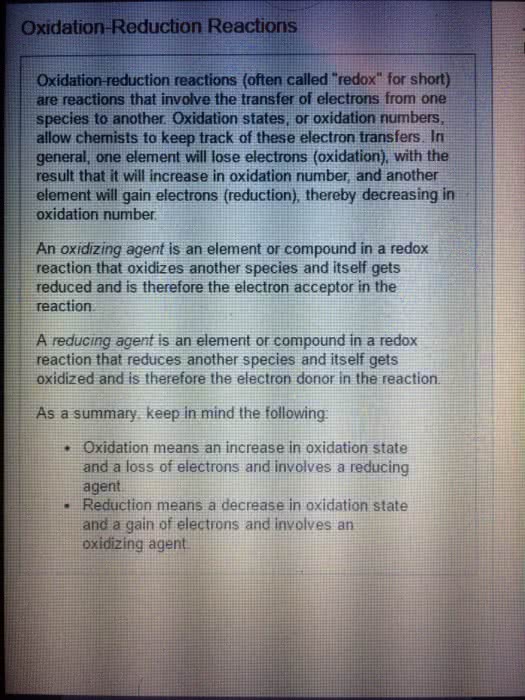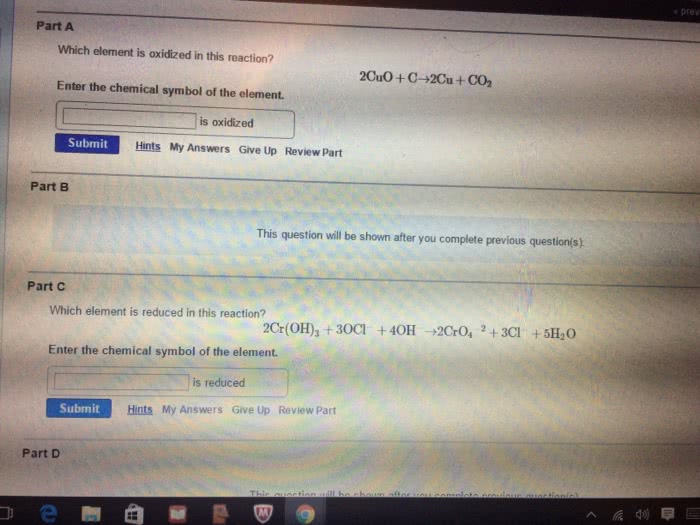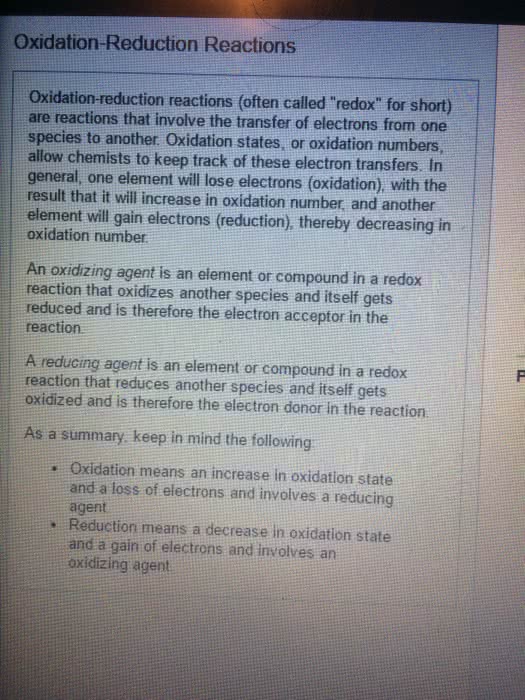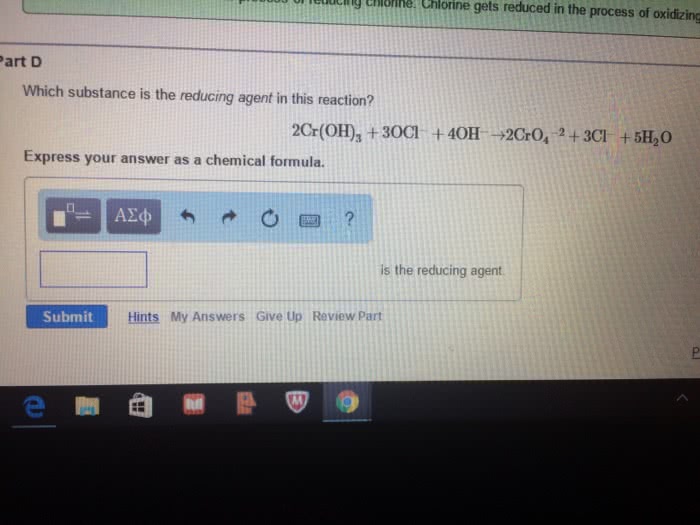CHEM10007 Lecture Notes - Lecture 18: Oxidation State, No Substance, Sodium Chloride

LECTURE 18 - REDOX REACTIONS
CHAPTER 12 - OXIDATION & REDUCTION
12.1 OXIDATION & REDUCTION
•Many processes involve the reaction of oxygen with a metal to produce a new compound (as
metal elements have a strong tendency to lose electrons)s, and these are among the most useful
and most adverse reactions in chemistry.
•Initially, the two types of reactions were defined as such; Oxidation is a reaction with oxygen and
reduction is the removal of oxygen (‘reducing’ the substance back to the elemental metal).
•The reactions of oxygen constitute a special case in which electrons are transferred from one
substance to another.
•Eg. The reaction between Na and Cl to give NaCl proceeds through the transfer of electrons from
Na (oxidation of Na) to Cl (reduction of Cl).
•Na = Na+ + e- oxidation
•½Cl2 + e- = Cl- reduction
•Note the electrons appear as a ‘product’ in oxidation and as a ‘reactant’ in reduction.
•Thus, the actual definitions of the two types of reactions are as follows; oxidation is the loss of
electrons and reduction is the gain of electrons. Collectively, electron transfer reactions are called
reduction-oxidation reactions or redox reactions.
OIL RIG - Oxidation Is Loss, Reduction Is Gain.
•Since positive and negative charges must always be balanced in a reaction, oxidation and
reduction always occur together. No substance is ever oxidised unless something else is reduced
too, and the total number of electrons lost by one substance is always the same as the total
number gained by the other.
‣Eg. For the Na and Cl reaction:
‣When 2 Na atoms are oxidised, 2 e- are lost b the sodium atoms, which is exactly the number
of e- gained when one Cl2 molecule is reduced. The electrons are transferred between the two
substances.
•An oxidizing agent or oxidant is then a substance that has the ability to remove electrons from
another substance (gains electrons itself). A reducing agent or reductant is a substance with the
ability to donate electrons to another substance (loses its electrons).
•The oxidant is reduced and the reductant is oxidised.
‣Eg. Na loses electrons and is the reductant and is oxidised."
Cl gains electrons and is the oxidant and is reduced.
‣Metals are always reductants. If oxygen is present, it is always an oxidant.
•The reason that many oxidation reactions involve metals and non metals such as oxygen or
chlorine is because metal elements have a strong tendency to lose electrons, and oxygen acquires a
completely filled outer valence shell by acquiring 2 electrons.
•Quickpoll Quiz 1:
•D. O2 + e- = O2- is a reduction reaction.
•This is not correctly balanced, although it is a
reduction reaction.

TRANSFER OF ELECTRONS
•The transfer of electrons is not always easily identified e.g. the combustion of methane.
•Carbon does not form ions, so this model of redox reactions is not suitable to explain that
combustion is a redox reaction.
OXIDATION NUMBERS
•Not all reactions with oxygen produce ionic products.
‣Eg. Sulfur + oxygen is a redox reaction, but the product sulfur dioxide, SO2, is covalent.
•To help us follow electron transfers in such reactions, we use the convenient concept of the
oxidation number. (oxidation numbers in covalent compounds are used for convenience and are
not ionic charges).
•The oxidation number or oxidation state is the hypothetical charge that an atom in a molecule
would possess if the shared electron pairs in each covalent bond were assigned to the more
electronegative element in the bond. Thus, the oxidation number is the charge that each atom
would have if the compound were divided into monatomic ions.
•Oxidation numbers provide a way of keeping track of electrons in oxidation-reduction reactions.
•In the combustion of methane (above), the assignment of oxidation numbers allows us to identify
methane (CH4) as the species that undergoes oxidation and oxygen (O2) as the species that is
reduced.
•The oxidation number of an element in a particular compound is assigned according to the rules:
•As well as the above rules, the following rules should be considered in assigning oxidation
numbers:
•1. All the metals in group 1 form ions with a 1+ charge. When we find sodium in a compound,
we can assign it an oxidation number of +1 because its simple ion, Na+, has a charge of 1+.
•2. All the metals in group 2 form ions with a 2+ charge. Calcium in a compound exists as Ca2+
and has an oxidation number of +2.
•3. In binary ionic compounds with metals, the non metals have oxidation numbers that are equal
to the charges on their anions. The Fe2O3 compound contains the oxide ion, O2-, which is
assigned an oxidation number of -2. The Mg3P2 compound contains the phosphide ion, P3-,
which has an oxidation number of -3.

•4. Adding H+ to anions does not result in a change of oxidation number.
‣Eg. S is +6 in SO42-, HSO4- and H2SO4.
•5. The most electronegative element will have the most negative oxidation number.
•Oxidation numbers for each element in a substance can be calculated by applying the rules above.
•The sum of the oxidation numbers must equal the net charge of the compound or ion.
•Oxidation numbers give the sign before the number, electrical charges have the sign after the
number. Eg. Sodium has an oxidation number of +1 and an electrical charge of 1+.
•Sometimes oxidation numbers are specified when the name is written out. Eg. ‘iron(III)’ means
iron with an oxidation number of +3.
•The rules above usually come into play when an element can have more than one oxidation
number, such as transition metals.
‣Eg. Iron can have Fe2+ and Fe3+ ions, so the rules help us determine which is present.
‣Eg. Nitrogen has 5 valence electrons, so it can gain up to 3 (-3) or lose up to 5 (+5), and can
have a range of oxidation numbers; -3, -2, -1, 0, +1, +2, +3, +4, +5.
•There are a few (rare) compounds with atoms in oxidation states that are exceptions to the above
rules. These include the oxygen atoms in peroxides (H2O2, the oxygen atoms have an oxidation
number of -1 instead of -2) and the hydrogen atoms I hydrides which have an oxidation number
of -1 instead of +1.
•Eg. PCl3 = x + 3(-1) = 0"
x - 3 = 0"
x = 3
•Eg. HPO42- = +1 + x + 4(-2) = -2"
x - 7 = -2"
x = 5
•Oxidation numbers calculated using the above rules can have fractional values.
‣Eg. The nitrogen atoms in sodium azide, NaN3, have an oxidation number of -⅓.
•Now that we know all of this, we can now view a redox reaction as one in which changes in
oxidation numbers occur.
•Oxidation is an increase in oxidation number (reductant). Reduction is a decrease in oxidation
number (oxidant).
•Note that each carbon has increased its oxidation number by +8, therefore C is oxidised.
•Each of the four O atoms reduces its oxidation number from 0 to -2 therefore O is reduced.
•Quickpoll Quiz 2:
•Quickpoll Quiz 3:
•A. Let x be
the oxidation
Document Summary
The reaction between na and cl to give nacl proceeds through the transfer of electrons from. Collectively, electron transfer reactions are called reduction-oxidation reactions or redox reactions. Oil rig - oxidation is loss, reduction is gain: since positive and negative charges must always be balanced in a reaction, oxidation and reduction always occur together. No substance is ever oxidised unless something else is reduced too, and the total number of electrons lost by one substance is always the same as the total number gained by the other: eg. For the na and cl reaction: when 2 na atoms are oxidised, 2 e- are lost b the sodium atoms, which is exactly the number of e- gained when one cl2 molecule is reduced. The electrons are transferred between the two substances: an oxidizing agent or oxidant is then a substance that has the ability to remove electrons from another substance (gains electrons itself).





